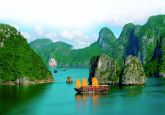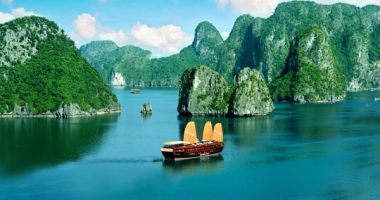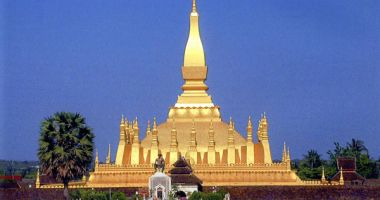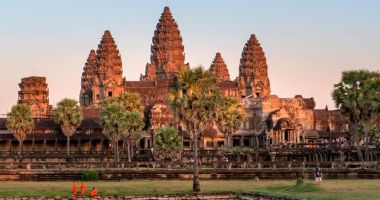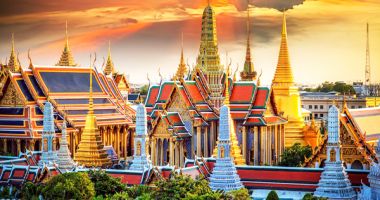Wildlife Tours
Spa Tours
Scuba Diving Trips
Trekking Tours
Road Trips
Kayaking Tours
Eco Tours
Culture Tours
Vietnam Travel Guide
Vietnam, a fascinating destination parking spectacular landscapes, rich history, and intriguing culture, has much to know . Going through this Vietnam travel guide , you could easily explore this fascinating country from the towering mountains in the north to the tropical beaches in the south, and all of the history as well as culture in between.
Stretching about 1.750 km all along the Indochina Peninsula, Vietnam geographically consists of many regions — Northern Vietnam: Northwest, Northeast, and Red River Delta; Central Vietnam: North Central Coast, South Central Coast, and Central Highlands; Southern Vietnam: Southeast and Mekong River Delta. However, each region is unique and different from not only the climate and natural beauty but also the people living style and food taste. Today, Vietnam is divided into 58 provinces and five municipalities, which are administratively on the same level as provinces. The capital city is Hanoi, but the largest city is Ho Chi Minh.
QUICK FACTS ABOUT Vietnam
Local Time | GMT+7h | |
Politic System | Socialist Republic | |
Capital City | Hanoi, Vietnam | |
Largest City | Ho Chi Minh City | |
Currency | Dong (VND) | |
Main religion | Buddhism (14.9%), Catholicism (8.5%), Caodaism (1.5% ), Hoahaoism (1.2%), No religion (73.5%) |
Drive | Right side | |
Calling Code | + 84 | |
| Police Emergency | Phone no: 113 | |
| Fire Emergency | Phone no: 114 | |
| Ambulance | Phone no: 115 | |
| Total Areas | 331,699 km2 | |
| Population | 96,208,984 ( in 2019) | |
More Information on Vietnam
Vietnam has a lengthy and complex history, with each layer still visible in modern Vietnam. To consider this a quick rundown on the basic backstory, you’ll need to understand and enjoy traveling and backpacking through Vietnam. About 2,000 years ago, people in North Vietnam began growing rice in the Red River valley. To irrigate their rice fields and protect against the flood, they built dikes and dug canals. The first dynasty, many believe, was the Hong Bang Dynasty, which was ruled by the legendary Hung kings. However, Vietnam was absorbed into China's Han Dynasty in 111 BC. The Chinese ruled northern Vietnam for more than 1,000 years and Chinese civilization had left many influence into the Vietnamese culture. Meanwhile the Southernmost region of Vietnam, a part of the state called Funan from the 1st century to the 6th century AD, undergone the Indian influence. At this period, the central Vietnam still belonged to an Indian-influenced state of Champa found in the 2nd century AD.
During the Chinese occupation, Vietnam recognized certain revolts. But only Ngo Quyen won the success in 938 and established the independence over Vietnam. Since then Vietnam was ruled by a succession of dynasties at the time, including the Dinh, Ly, Tran and Le. There was a long period of peace intercalated with short warfare against the central empire. However, the Cham kingdom in central Vietnam often lost the battle and forced to cede a part of the country to the northern reigns, especially under the Le Dynasty.
The Mongols invaded Vietnam three times but failed to occupy Vietnam for long time although they successfully captured the Vietnamese capital in 1257 and 1284. The big defeat of Mongols was in 1288 in the Bach Dang Naval battle leaded by the general Tran Hung Dao. The peace come back to Vietnam but lasted until end of 14th century only. To regain the control over Northern Vietnam, China had launched certain offensives and finally took over the Northern Vietnam in 1407. Escaping from the Chinese’s hands in 1428 by insurrection of Le Loi, Vietnam was ruled by the later Le dynasty. In early 16th century, the Le dynasty declined, paying the path to two powerful families’ conflict: the Trinh in northern and the Nguyen in south during the 17th and 18th centuries. The Nguyen family conquered the Mekong Delta from the Khmer Empire.
The French arrived in Vietnam in 1858 and later incorporated it into French Indochina. France ruled until 1954, when it was defeated by communist forces led by Ho Chi Minh. Vietnam was divided into Communist North Vietnam and anti-Communist South Vietnam. For years, the Vietnam War raged between the two countries, with the US siding with the south and communist nations siding with the north. In 1975, the North succeeded in uniting the country under communist rule.
It would be ideal if the conflict ended there. But just after end of the Vietnam War, the Khmer Rouge had attacked Vietnam in the southwest and kept continuing its offensive for three years. Because of this reason, Vietnam had to send its troops to Cambodia in late 1978, deposing the Khmer Rouge and Pol Pot, and then stayed there until 1989. This attack had caused a ceaseless battle between China and Vietnam since early 1979. However, the relation between Vietnam and China come back to normal step by step in 1990.
Meanwhile the Vietnamese government introduced market reforms in 1986 and as a result, the Vietnamese economy began to grow rapidly. In 1994 the USA lifted an economic embargo on Vietnam and in 1995 diplomatic relations were restored. Today the Vietnamese economy is booming and more prosperous. Tourism is an important industry in Vietnam. Furthermore, a stock exchange opened in Vietnam in 2000.
HIGHLIGHTS OF Vietnam

Sapa, Vietnam - Travel guide

Lai Chau, Vietnam - Travel guide

Phu Quoc Island , Vietnam - Travel guide

Can Tho, Vietnam - Travel guide
You Tell Us
We Work On
You Select Up
SHARING TRAVEL EXPERIENCE
The personalized, distinctive experience unveils the best things in Vietnam; top rated hotels, popular restaurants, funny shopping , essential highlights, entertainment and nightlife. This travel information helps you to plan wonderful holidays in Vietnam at low cost possible
Vietnam FREQUENT ASK QUESTIONS
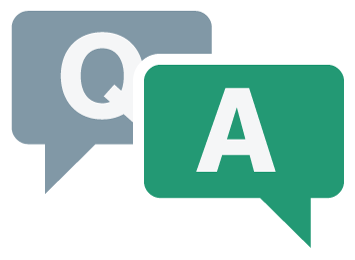

CLICK TO READ
Do I need a visa to travel to Vietnam?


How to apply for a Vietnam visa ?


Does Vietnam offer visas on arrival?


How to apply for Vietnam e-visa ?


Do I need a visa to visit Phu Quoc Island?


Do I need a visa to visit Phu Quoc Island?


What are the most common sicknesses travellers get in Vietnam?


Is there risk of malaria and dengue fever in Vietnam?


What is the internet access like in Vietnam?


Can I use my mobile/cell phone while in Vietnam?


Are credit cards accepted widely in Vietnam?


What is ATM access like in Vietnam?


What festivals are celebrated in Vietnam?


ARTICLES ON TRAVEL IN Vietnam

TOPIC: Vietnam
Travel Vietnam At Low Budget

TOPIC: Vietnam
Find Best Egg Coffee In Hanoi, Vietnam

TOPIC: Vietnam
Night Life In Ho Chi Minh City, Vietnam

TOPIC: Vietnam

